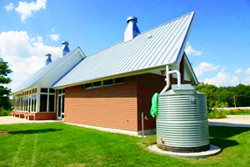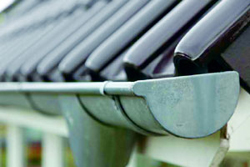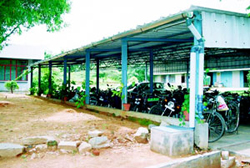Rainwater Harvesting in Industries
Industries are booming in Bangalore and environs. A 10 % economic growth rate also means a 10% growth in water demand. Since industries are usually located in the periphery of the city they are not usually connected to the piped network of the city and depend on ground water for their needs. If they are indeed connected, industries pay one of the highest tariffs for water in India - at an effective Rs 72 /- a kilo–litre in Bangalore for example. Many industries buy water from water tankers too. Some buy bottled water for drinking purpose and if soft water is required as part of the process requirement water softeners or reverse osmosis systems are opted for.
 |
 |
|
It therefore makes eminent sense for industries to harvest rainwater because it saves money, it replenishes the ground water and it brings to productive use soft rain water.
How should industry harvest rain? Rainwater harvesting is collecting and storing rain for future productive use. The 'principle' of rainwater harvesting remains the same for industries as for other needs - collect and store rainwater or
- recharge the aquifer and use the ground as storage if conditions are amenable.
|
 |
Design of the rainwater harvesting system Modern tools like 'google earth' are available which helps identify the catchment of your industry if it is large, the slopes, the land use within and outside and the overall context where it is located in the urban watershed. This helps plan, design and implement rainwater harvesting systems better from a couple of acres to thousands of acres.
| Identification is first made of the type and nature of the catchment both within and outside the industry. Externally some components that need clarity include the presence of a valley or storm drain which may bring rainwater in from outside the premises. The presence of lakes and tanks nearby which may indicate the potential of ground water. The presence of a forest or a park upstream which may suggest good clean run off coming in to the site. The presence of air pollution from outside and inside the industry needs to be clearly established and managed. |
 |
Within the industry itself, catchments and their slopes need to be identified like roofs, paved areas and unpaved areas. The quality of catchment and the potential quality of rainwater should be clearly established.
A good catchment management strategy should be set in place to ensure continuous monitoring and maintaining the quality of runoff.
Components: In terms of the components of rainwater harvesting systems there are principally five
- catchment
- conveyance
- filtration
- storage and
- recharge
Catchment
Roofs are excellent catchment. Paved areas which are clean can also be treated as a catchment. Unpaved areas are usually best reserved to ensure increase in soil moisture or to recharge groundwater. Many factories have sloping roofs and some have flat roofs. Irrespective of the kind of roof each of them is an excellent catchment as long as it is kept clean. The use of bitumen and asphalt as water proofing in some of the old factories may render the catchment unfit. The use of chimneys which deposit soot or other effluents may need for these areas to be isolated from harvesting rain. Other than that, all types of roofs are good for catching rain.
Conveyance systems are things like rainwater gutters and down pipes which move the rainwater from the catchment to the filtration system. It is good to build gutters at the construction stage itself and to slope it in the direction of storage or recharge. Down pipes should also be built in for easy connections. Usually PVC is the material used for both gutters and down pipes though other materials are also now coming in.
Selection of high quality material of appropriate dimensions and gauge is critical to the performance of the system. Pipes and gutters should be UV resistant and capable of long life and rough handling. The joints and fixtures should be clean and not prone to leakages.
Filtration systems remove organic material, silt and other debris from the rooftop rainwater. These are designed with gravel and sand and sometimes with nylon meshes of various quality of sieving potential. Rainwater passes through the filter and physical impurities are removed – especially organic material which may decompose before storage.
Storage of rain: There are many ways to store rainwater. Rain barrels are one method where HDPE tanks are used to collect and store rainwater. Underground open or closed sumps are preferred by some. For storage, it should be remembered that open systems lend themselves to evaporation losses, vector breeding and algal growth. Underground sump tanks or closed containers preserve water quality for longer duration.
Precautions are needed to ensure overflow provision during heavy rains to prevent flooding.
Recharge structures
These take the rainwater and allow it to go into the shallow aquifer or the deeper aquifer at fairly rapid rates. These can be recharge pits or recharge wells. Some industries with large areas have even used recharge ponds.
Storm water drains are conveyance systems for larger catchments and are excellent places to harvest storm water. Recharge wells can be placed inside the storm water drains or immediately adjacent to it in series to ensure maximum recharge. Storm drains can also be led to recharge ponds of 2 to 10 lakh litres capacity to store and recharge the groundwater.
For the landscaped areas, swales and berms capture water and soak it into the soil increasing soil moisture and enabling plants to thrive. A well designed landscape in an industry will do with very little water or only treated effluent water should be sufficient. It is always wise to work with tree based landscapes or with plants which demand very less water.
Water audits
A water audit and a clear identification of the demand of water at various points through appropriate metering is an excellent idea. For example an industry should know its sources of water – like bore wells, tankers, piped connection- and how much water is consumed from these sources in each month and should monitor it closely. Water can only be managed if you measure it. Key points of demand should also be measured to see how much efficiencies can be brought in to optimize it.
Demand segregation into different qualities of use also helps in matching appropriate supply and demand.
Through a clear demand management strategy, rainwater harvesting and recycling water an industry can become a water smart industry or a water positive industry. This will contribute ecologically and economically for sustainable development.
[S Vishwanath is a Bangalore-based Urban Planner and the founder of the ‘Rainwater Club’]